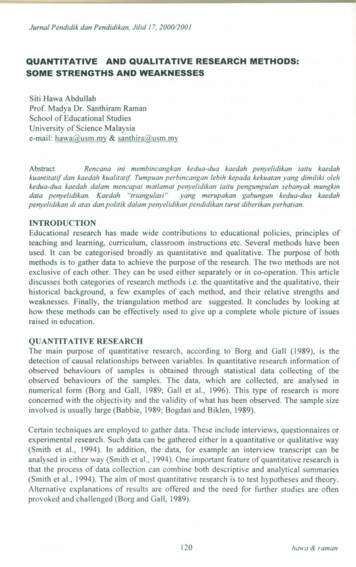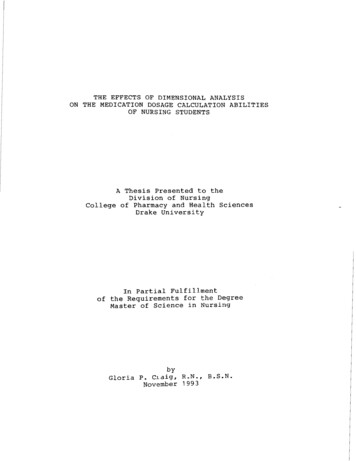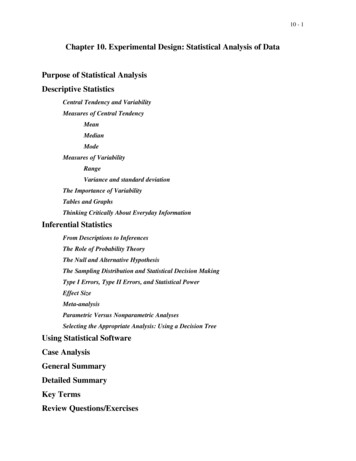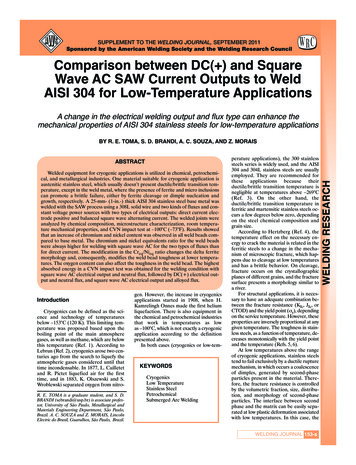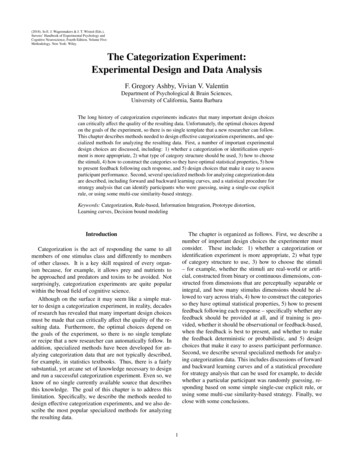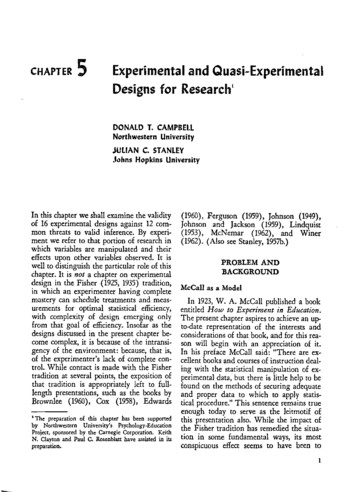
Transcription
CHAPTER5Experimental and Quasi-ExperimentalDesigns for ResearchlDONALD T. CAMPBELLNorthwestern UniversityJULIAN C. STANLEYJohns Hopkins UniversityIn this chapter we shall examine the validityof 16 experimental designs against 12 common threats to valid inference. By experiment we refer to that portion of research inwhich variables are manipulated and theireffects upon other variables observed. It iswell to distinguish the particular role of thischapter. It is not a chapter on experimentaldesign in the Fisher (1925, 1935) tradition,in which an experimenter having completemastery can schedule treatments and meas urements for optimal statistical efficiency,with complexity of design emerging onlyfrom that goal of efficiency. Insofar as thedesigns discussed in the present chapter become complex, it is because of the intransigency of the environment: because, that is,of the experimenter's lack of complete control. While contact is made with the Fishertradition at several points, the exposition ofthat tradition is appropriately left to fulllength presentations, such as the books byBrownlee (1960), Cox (1958), Edwards1The preparation of this chapter bas been supportedby Northwestern University's PsychologY-EducationProject, sponsored by the Carnegie Corpora.tion. KeithN. Clayton and Paul C. Rosenblatt have assisted in itspreparation.(1960), Ferguson (1959), Johnson (1949),Johnson and Jackson (1959), Lindquist(1953), McNemar (1962), and Winer(1962). (Also see Stanley, 19S7b.)PROBLEM ANDBACKGROUNDMcCall as a ModelIn 1923, W. A. McCall published a bookentitled How to Experiment in Education.The present chapter aspires to achieve an upto-date representation of the interests andconsiderations of that book, and for this reason will begin with an appreciation of it.In his preface McCall said: "There afe excellent books and courses of instruction dealing with the statistical manipulation of ex;perimental data, but there is little help to befound on the methods of securing adequateand proper data to which to apply statistical procedure." This sentence remains trueenough today to serve as the leitmotif ofthis presentation also. While the impact ofthe Fisher tradition has remedied the situation in some fundamental ways, its mostconspicuous effect seems to have been to
2DONALD T. CAMPBELL AND JUUAN C. STANLEYelaborate statistical analysis rather than totfaid in securing "adequate and proper data.Probably because of its pnictical and com mon·sense orientation, and its lack of pretension to a more fundamental contribution,McCall's book is an undervalued classic. Atthe time it appeared, two years before thefirst edition of Fisher's Statistical Methodsfor Research Workers (1925), there wasnothing of comparable excellence in eitheragriculture or psychology. It anticipated theorthodox methodologies of these other fieldson several fundamental points. PerhapsFisher's most fundamental contribution hasbeen the concept of achieving pre-experimen tal equation of groups through randomization. This concept, and with it the rejectionof the concept of achieving equation throughmatching (as intuitively appealing and misleading as that is) has been difficult foreducational researchers to accept. In 1923,McCall had the fundamental qualitative understanding. He gave, as his first method ofestablishing comparable groups, "groupsequated by chance." "Just as representativeness can be secured by the method of chance, . so equivalence may be secured by chance,provided the number of subjects to be used issufficiently numerous" (p. 41). On anotherpoint Fisher was also anticipated. Under theterm "rotation experiment," the Latin.squaredesign was introduced, and, indeed, hadbeen used as early as 1916 by Thorndike,McCall, and Chapman (1916), in both 5 X 5and 2 X 2 forms, Le., some 10 years beforeFisher (1926) incorporated it systematicallyinto his scheme of experimental design, withrandomization.2McCall's mode of using the Cfrotation experiment" serves well to denote the emphasisof his book and the present chapter. The rotation experiment is introduced not for rea·sons of efficiency but rather to achieve somedegree of control where random assignmentto equivalent groups is not possible. In a similar vein, this chapter will examine the imper-fections of numerous experimental schedulesand will nonetheless advocate their utilization in those settings where better experimental designs are not feasible. In this sense, amajority of the designs discussed, includingthe unrandomized Clrotation experiment,Uare designated as quasi-experimental designs.Disillusionment withExperimentation in EducationThis chapter is committed to the experi ment: as the only means for settling disputesregarding educational practice, as the onlyway of verifying educational improvements,and as the only way of establishing a cumulative tradition in which im provements canbe introduced without the danger of a faddish discard of old wisdom in favor of inferior novelties. Yet in our strong advocacyof experimentation, we must not imply thatour emphasis is new. As the existence of Mc Call's book makes clear, a wave of enthusiasm for experimentation dominated the fieldof education in the Thorndike era, perhapsreaching its apex in the 19205. And this enthusiasm gave way to apathy and re1ection,and to the adoption of new psychologies unamenable to experimental verification. Goodand Scates (1954, pp. 716-721) have documented a wave of pessimism, dating back toperhaps 1935, and have cited even thatstaunch advocate of experimentation, Monroe (1938), as saying "the direct contributionsfrom controlled experimentation have beendisappointing.',t Further, it can be noted thatthe defections from experimentation to essaywriting, often accompanied by conversionfrom a Thorndikian behaviorism to Gestaltpsychology or psychoanalysis, have frequently occurred in persons well trained in theexperimental tradition.To avoid a recurrence of this disillusionment, we must be aware of certain sources ofthe previous reaction and try to avoid thefalse anticipations which led to it. Several aspects may be noted. First, the claims madeI Kendall and Buckland (1957) say that the Latinsquare was invented by the mathematician Euler in 1782. for the rate and degree of progress whichwould result from experiment were grandiThorndike, Chapman. and McCall do not use this term.
EXPERIMENrAL AND QUASI·EXPERIMENTAL DESIGNS FOR RESEARCHosely overoptimistic and were accompaniedby an unjustified depreciation of nonexperi.mental wisdom. The initial advocates as·sumed that progress in the technology ofteaching had been slow just hecause scientific method had not been applied: they as sumed traditional practice was incompetent,just because it had not been produced byexperimentation. When, in fact, experimentsoften proved to be tedious, equivocal, of un·dependable replicability, and to confirm prescientific wisdom, the overoptimistic groundsupon which experimentation had been justi.fied were undercut, and a disillusioned rejec.tion or neglect took place.This disillusionment was shared by bothobserver and participant in experimentation.For the experimenters, a personal avoidance·conditioning to experimentation can benoted. For the usual highly motivated re·searcher the nonconfirmation of a cherishedhypothesis is actively painfu1. As a biologicaland psychological animal, the experimenteris subject to laws of learning which lead himinevitably to associate this pain with the con·tiguous stimuli and events. These stimuliare apt to be the experimental process itself,more vividly and directly than the "true"source of frustration, i.e., the inadequatetheory. This can lead, perhaps unconsciously,to the avoidance or rejection of the experimental process. If, as seems likely, the ecol·ogy of our science is one in which there areavailable many more wrong responses thancorrect ones, we may anticipate that most experiments will be disappointing. We mustsomehow inoculate young experimentersagainst this effect, and in general must jus.tify experimentation on more pessimisticgrounds-not as a panacea, but rather as theonly available route to cumulative progress.We must instill in our stud nts the expecta·tion of tedium and disappointment and theduty of thorough persistence, by now so wellachieved in the biological and physicalsciences. We must expand our students' vowof poverty to include not only the willingnessto accept poverty of finances, but also apoverty of experimental results.3More specifically, we must increase ourtime perspective, and recognize that continuous, multiple experimentation is more typ ica! of science than once-and-for-all definitiveexperiments. The experiments we do today,if successful, will need replication and crossvalidation at other times under other conditions before they can become an establishedpart of science, before they can be theoretically interpreted with confidence. Fur ther, even though we recognize experimentation as the basic language of proof, as theonly decision court for disagreement betweenrival theories, we should not expect that"crucial experiments" which pit opposingtheories will be likely to have clear-cut outcomes. When one finds, for example, thatcompetent observers advocate strongly divergent points of view, it seems likely on apriori grounds that both have observedsomething valid about the natural situation,and that both represent a pnrt of the truth.The stronger the controversy, the more likelythis is. Thus we might expect in such casesan experimental outcome with mixed results, or with the balance of truth varyingsubtly from experiment to experiment. Themore mature focus-and one which experimental psychology has in large part achieved(e.g., Underwood, 1957b)-avoids crucialexperiments and instead studies dimensionalrelationships and interactions along manydegrees of the experimental variables.Not to be overlooked, either, are thegreatly improved statistical procedures thatquite recently have filtered slowly intopsychology and education. During the periodof its greatest activity, educational experimentation proceeded ineffectively with blunttools. McCall (1923) and his contemporariesdid one-variable-at-a-time research. For theenormous compleXities of the human learning situation, this proved too limiting. Wenow know how important various contingencies-dependendes upon joint Uaction"of two or more experimental variables--eanbe. Stanley (1957a, 1960, 1961b, 1961c, 1962),Stanley and Wiley (1962), and others havestressed the assessment of such interaction:;.
4DONALD T. CAMPBELL AND JUUAN C. STANLEYExperiments may be multivariate in eitheror both of two senses. More than one "inde pendene' variable (sex, school grade, methodof teaching arithmetic, style of printing type,size of printing type, etc.) may be incorpo rated into the design and/or more than oneudependent" variable (number of errors,speed, number right, various tests, etc.) maybe employed. Fisher's procedures are multivariate in the first sense, univariate in thesecond. Mathematical statisticians, e.g., Royand Gnanadesikan (1959), are working toward designs and analyses that unify the twotypes of multivariate designs. Perhaps bybeing alert to these, educational researcherscan reduce the usually great lag betweenthe introduction of a statistical procedureinto the technical literature and its utilization in substantive investigations.Undoubtedly, training educational researchers more thoroughly in modern experimental statistics should help raise thequality of educational experimentation.Evolutionary Perspective onCumulative Wisdom and ScienceUnderlying the comments of the previousparagraphs, and much of what follows, isan evolutionary perspective on knowledge(Campbell, 1959), in which applied practiceand scientific knowledge are seen as the re·sultant of a cumulation of selectively retained tentatives, remaining from the hoststhat have been weeded out by experience.Such a perspective leads to a considerablerespect for tradition in teaching practice. 1ftindeed, across the centuries many differentapproaches have been tried, if some approaches have worked better than others,and if those which worked better have there fore, to some extent, been more persistentlypracticed by their originators, or imitatedby others, or taught to apprentices, then thecustoms which have emerged may representa valuable and tested subset of all possiblepractices.But the selective, cutting edge of this process of evolution is very imprecise in the nat-ural setting. The conditions of observation,both physical and psychological, are far fromoptimal. What survives or is retained is determined to a large extent by pure chance.Experimentation enters at this point as themeans of sharpening the relevance of thetesting, probing, selection process. Experimentation thus is not in itself viewed as asource of ideas necessarily contradictory totraditional wisdom. It is rather a refiningprocess superimposed upon the probably val uable cumulations of wise practice. Advocacy of an experimental science of educationthus does not imply adopting a position incompatible with traditional wisdom.Some readers may feel a suspicion that theanalogy with Darwin's evolutionary schemebecomes complicated by specifically humanfactors. School principal John Doe, when confronted with the necessity for decidingwhether to adopt a revised textbook or retain the unrevised version longer, probablychooses on the basis of scanty knowledge.Many considerations besides sheer efficiencyof teaching and learning enter his mind. Theprincipal can be right in two ways: keep theold book when it is as good as or better thanthe revised one, or adopt the revised bookwhen it is superior to the unrevised edition.Similarly, he can be wrong in two ways:keep the old book when the new one is better, or adopt the new book when it is nobetter than the old one.'·Costs" of several kinds might be estimated roughly for each of the two erroneouschoices: (1) financial and energy-expenditure cost; (2) cost to the principal in complaints from teachers, parents, and schoolboard members; (3) cost to teachers, pupils,and society because of poorer instruction.These costs in terms of money, energy, con·fusion, reduced learning, and personal threatmust be weighed against the probability thateach will occur and also the probability thatthe error itself will be detected. If the principal makes, his decision without suitableresearch evidence concerning Cost 3 (poorerinstruction), he is likely to overemphasizeCosts 1 and 2. The cards seem stacked in
EXPERIMENTAL AND QUASI-EXPERIMENTAL DESIGNS FOR RESEARCHfavor of a conservative approach-that is,retaining the old book for another year. Wecan, however, try to cast an experiment withthe two books into a decision-theory mold(Chernoff & Moses, 1959) and reach a decision that takes the various costs and probabilities into consideration explicitly. How nearlythe careful deliberations of an excellent educational administrator approximate this decision-theory model is an important problemwhich should be studied.Factors JeopardizingIntemal and External ValidityIn the next few sections of this chapter wespell out 12 factors jeopardizing the validityof various experimental designs.3 'Each factor will receive its main exposition in thecontext of those designs for which it is a particular problem, and 10 of the 16 designs willbe presented before the list is complete. Forpurposes of perspective, however, it seemswell to provide a list of these factors and ageneral guide to Tables 1, 2, and 3, whichpartially summarize the discussion. Fundamental to this listing is a distinction betweeninternal validity and external validity. Internal validity is the basic minimum without.which any experiment is uninterpretable:Did in fact the experimental treatmentsmake a difference in this specific experimental instance? External validity asks thequestion of generalizability: To what populations, settings, treatment variables, andmeasurement variables can this effect be generalized? Both types of criteria are obviouslyimportant, even though they are frequentlyat odds in that features increasing one mayjeopardize the other. While internal validityis the sine qua non I and while the questionof external validity, like the question of inductive inference, is never completely answerable, the selection of designs strong inboth types of validity is obviously our ideal.This is particularly the case for research onMuch of this presentation is based upon Campbell(1957). Specific citations to this source will, in general,Inot be made.5teaching, in which generalization to appliedsettings of known character is the desideratum. Both the distinctions and the relationsbetween these two classes of validity considerations will be made more explicit as theyare illustrated in the discussions of specificdesigns.Relevant to internal validity, eight different classes of extraneous variables will bepresented; these variables, if not controlledin the experimental design, might produceeffects confounded with the effect of theexperimental stimulus. They represent the"effects of:L History, the specific events occurringbetween the first and second measurementin addition to the experimental variable.2 Maturation, processes within the respondents operating as a function of the pas sage of time per se (not specific to the particuIar events), including growing older,growing hungrier, growing more tired, andthe like.3. Testing, the effects of taking a test uponthe scores of a second testing.4. Instrumentation, in which changes inthe calibration of a measuring instrumentor changes in the observers or scorers usedmay produce changes in the obtained measurements.5. Statistical regression, operating wheregroups have been selected on the basis oftheir extreme scores.6. Biases resulting in differential selectionof respondents for the comparison groups.7. Experimental mortality, or differentialloss of respondents from the comparisongroups.8. Selection-maturation interaction, etc.twhich in certain of the mu]tiple groupquasi-experimental designs, such as Design10, is confounded with, i.e., might be mistaken for, the effect of the experimentalvariable.The factors jeopardizing external tJalidityor representativeness which will be discussedare:9. The reactive or interaction effect oftesting, in which a pretest might increase or
6DONALD TCAMPBELL AND JULIAN C. STANLEYdecrease the respondent's sensitivity or responsiveness to the experimental variableand thus make the results obtained for apretested population unrepresentative of theeffects of the experimental variable for theunpretested universe from which the experimental respondents were selected.10. The interaction effects of selectionbiases and the experimental variable.11. Reactive effects of experimental arrangements, which would preclude generali.zation about the effect of the experimentalvariable upon persons being exposed to it innonexperimental settings.12. Multiple-treatment interference, likelyto occur whenever multiple treatment!; areapplied to the same respondents, because theeffects of prior treatments are not usuallyerasable. This is a particular problem for onegroup designs of type 8 or 9.In presenting the experimental designs, auniform code and graphic presentation willbe employed to epitomize most, if not all, oftheir distinctive features. An X will repre sent the exposure of a group to an experimental variable or event, the effects of whichare to be measured; 0 will refer to someprocess of observation or measurement; theXs and Os in a given row are applied to thesame specific persons. The left-to-right dimension indicates the temporal order, andXs and Os vertical to one another are simultaneous. To make certain important distinc tions, as between Designs 2 and 6, or betweenDesigns 4 and 10, a symbol R, indicatingrandom assignment to separate treatmentgroups, is necessary. This randomization isconceived to be a process occurring at a specific time, and is the all-purpose procedure forachieving pretreatment equality of groups,within known statistical limits. Along withthis goes another graphic convention, in thatparallel rows unseparated by dashes representcomparison groups equated by· randomization, while those separated by a dashed linerepresent comparison groups not equated byrandom assignment. A symbol for matchingas a process for the pretreatment equating ofcomparison groups has not been used, becausethe value of this process has been greatlyoversold and it is more often a source of mis.taken inference than a help to valid infer ence. (See discussion of Design 10, and thefinal section on correlational designs, below.)A symbol M for materials has been used in aspecific way in Design 9.THREEPRE-EXPERIMENTALDESIGNSt.TH:B ONE-SHOT CASE STUDYMuch research in education today con forms to a design in which a single group isstudied only once, subsequent to some agentor treatment presumed to cause change. Suchstudies might be diagramed as follows:x0As has been pointed out (e.g., Boring, 1954;Stouffer, 1949) such studies have such a totalabsence of control as to be of almost noscientific value. The design is introducedhere as a minimum reference point. Yet be cause of the continued investment in suchstudies and the drawing of causal inferencesfrom them, some comment is required.Basic to scientific evidence (and to all knowledge.diagnostic processes including the ret ina of the eye) is the process of comparison,of recording differences, or of contrast. Anyappearance of absolute knowledge, or in trinsic knowledge about singular isolatedobjects, is found to be illusory upon analysis.Securing scientific evidence involves makingat least one comparison. For such a comparison to be useful) both sides of the compari son should be made with similar care andprecision.In the case studies of Design 1, a carefullystudied single instance is implicitly com pared with other events casually observedand remembered. The inferences are basedupon general expectations of what the datawould have been had the X not occurred,
EXPERIMENTAL AND QUASI·EXPERIMENTAL DESIGNS FOR RESEARCH70 1 X 02etc. Such studies often involve tedious collection of specific detail, careful observation,The first of these uncontrolled rival hytesting, and the like, and. in such inst ces potheses is history. Between 0 1 and 02 manyinvolve the error of mIsplaced prectslOn. other change-producing events may haveHow much more valuable the study would occurred in addition to the experimenter's X.be if the one set of observations were re- If the pretest Ot) and the posttest (0 2 ) areduced by half and the sa ed effort directe to made on different days, then the events inthe study in equal detail of an appropnate between may have caused the difference. Tocomparison instance. It seems well-nigh un- become a plausible rival hypothesis, such anethical at the present time to allow, as theses event should have occurred to most of theor dissertations in education, case studies of students in the group under study, say inthis nature (Le., involving a single group some other class period or via a widely dis observed at one time only). "Standardized" seminated news story. In Collier's classroomtests in such case studies provide only very study (conducted in 1940, but reported inlimited help, since the rival sources of differ- 1944), while students were reading Nazience other than X are so numerous as to propaganda materials, France fell; the attirender the "standard" reference group almost tude changes obtained seemed more likely touseless as a Ucontrol group." On the same be the result of this event than of the pr6pa grounds, the many uncontrolled sources of ganda itself! History becomes a more plau difference between a present case study and sible rival explanation of change the longerpotential future ones which might be com the 01-02 time lapse, and might be re pared with it are so numero s. as to make garded as a trivial problem in an experimentjustification in terms of provIdmg a bench completed within a one- or two hour period,mark for future studies also hopeless. In although even here, extraneous sources suchgeneral, it would be better to ap rtion the as laughter, distracting events, etc., are to bedescriptive effort between both SIdes of an looked for. Relevant to the variable historyinteresting comparison.is the feature of experimental isolation Design 1, if taken in conjunction wit.h the which can so nearly be achieved in manyimplicit ('common-knowledge" comparisons, physical science laboratories as to renderhas most of the weaknesses of each of the Design 2 acceptable for much of their resubsequent designs. For this reason, the spell- search. Such effective experimental isolationing out of these weaknesses will be left to can almost never be assumed in research onthose more specific settings.teaching methods. For these reasons a minushas been entered for Design 2 in Table 1under History . We will classify with history2. THE ONEwGROUPa group of possible effects of season or of inPR.ETEST-POSTIEST DESIGNstitutional.evem schedule, although theseWhile this design is still widely used in might also be placed with maturation. Th seducational research, and while it is judged optimism might vary with seasons and anXIas enough better than Design 1 to be worth ety with the semester examination scheduledoing where nothing etter n be done . see (e.g., Crook, 1937; Windle, 1954). Such ef the discussion of quasl-expen!!lental desIgns fects might produce an 01-02 change conbelow), it is introduced here as a "bad ex- fusable with the effect of X.ample" to illustrate several of the c n oun edA second rival variable, or class of variextraneous variables that can Jeopardize ables, is designated maturation. This term isinternal validity. These variables offer pIau. used here to cover all of those biological orsible hypotheses explaining n 01-02 differ·ence rival to the hypothesis that X caused 'Collier actually used a more adequate design thanthis, designated Design to in the present system.the difference:
8DONALD T. CAMPBEll AND JUUAN C. STANLEYTABLE 1SOURCES OF INVALIDITY FOR DESIGNS 1 THROUGH6Sources of InvalidityInternalExternald0'05dd0 B'S34)b.(). :E ::a '"II)Pre. erimentaJDesigns:ne-Shot Case StudyX01.2. One-Group Prerest-Posttest DesignX0t'lI- - - -8EHd.SU':I - -?Incc:'1\l34.jen\w cClSCCddcu 0 .2e·gtL9 (I;! ::s t;S 0""0.9CISt .t%8 .5R- -0c::.2 c o '8 CI)Celi 54JE \l) --- -? ? ? -"3e .s- 8'e::4J11,j'8 o3. Static-GroupComparisonX 0 o c:: 0 4J-?--------0-True Experimental Designs:4. Pretest-Posttest Control Group DesignR 0 X0R005. SolomonFour GroupDesignR 0 XR 0RXR00006. Posttest-Only ControlGroup DesignRIRX00Note: In the tables, a minus indicates a definite weakness, a plus indicates that the factor is can·trolled, a question mark indicates a possible source of concern, and a blank. indicates that the factoris not relevant.It is with extreme reluctance that these summary tables are presented because they are apt to be"too helpful;' a.nd to be depended upon in pla.ce of the more complex and qualified presentationin the text. No or - indicator should be respected unless the reader comprehends why it is placedthere. In particular. it is against the spirit of this presentation to create uncomprehended fears of,or confidence in, specific designs.psychological processes which systematicallyvary with the passage of time, independentof specific external events. Thus between 01and O2 the students may have grown older,hungrier, more tired, more bored, etc., andthe obtained difference nlay reflect this proc.ess rather than X. In remedial education,which focuses on exceptionally disadvantaged persons, a process of Uspontaneous remission," analogous to wound healing, maybe mistaken for the specific effect of a reme dial X. (Needless to say, such a remission isnot regarded as "spontaneous" in any causalsense, but rather represents the cumulative
EXPERIMENTAL AND QUASI-EXPERIMENTAL DESIGNS FOR RESEARCH9effects of learning processes and environ- change that which is being measured. Themental pressures of the total daily experience, test-retest gain would be one important aswhich would be operating even if no X had pect of such change. (Another, the interaction of testing and X will be discussedbeen introduced.)A third confounded rival explanation is with Design 4, below. Furthermore, these rethe effect of testing the effect of the pretest actions to the pretest are important to avoiditself. On achievement and intelligence tests, even where they have different effects forstudents taking the test for a second time, or different examinees.) The reactive effect cantaking an alternate form of the test, etc., be expected whenever the testing process isusually do better than those taking the test in itself a stimulus to change rather than afor the first time (e.g., Anastasi, 1958, pp. passive record of behavior. Thus in an ex190-191; Cane & Heim, 1950). These effects, periment on therapy for weight control, theas much as three to five IQ points on the initial weigh-in might in itself be a stimulusaverage for naive test-takers, occur without to weight reduction, even without the theraany instruction as to scores or items missed peutic treatment. Similarly placing observerson the first test. For personality tests, a simi- in the classroom to observe the teacher'slar effect is noted, with second tests showing, pretraining human relations skills may inin general, better adj ustment, although occa- itself change the teacher's mode of discipline.sionally a highly significant effect in the op- Placing a microphone on the desk mayposite direction is found (Windle, 1954). change the group interaction pattern, etc. InFor attitudes toward minority groups a sec- general, the more novel and motivating theond test
design was introduced, and, indeed, had been used as early as 1916 by Thorndike, McCall, andChapman (1916), in both 5 X 5 and 2 X 2 forms, Le., some 10 years before Fisher (1926) incorporated it systematically intohis scheme of experimental design, with randomization.2 McCall's mode of usi




